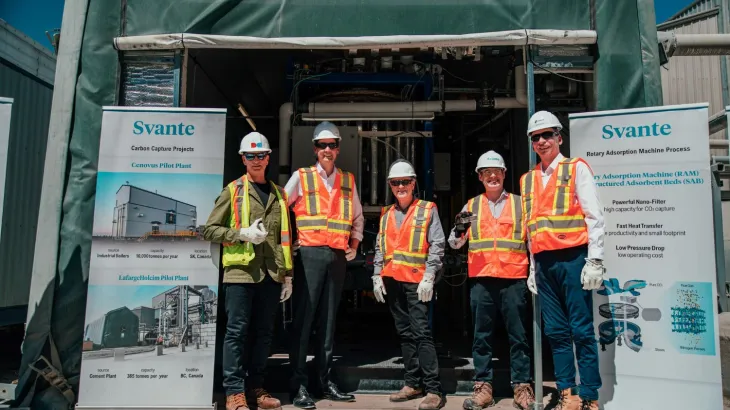PROJECT CO2MENT FAQS
Project CO2ment is a project partnership between Lafarge Canada, Svante, and Total Energies to demonstrate Svante’s carbon capture technology at the Richmond cement plant. The project began in 2019 and consisted of three phases, pre-treatment, capture and utilization; the demonstration is currently embarking upon the third last phase, utilization.
The Richmond Plant was built in 1956 and was Lafarge’s first cement plant outside of France. The plant underwent modernization in 1996 with the installation of a new pre-heater pre-calciner kiln. The Richmond plant is one of two cement plants in BC and supplies cement to the greater Vancouver area, Vancouver Island, the BC Interior and Pacific Northwest.
For Lafarge, sustainable development is a long-standing commitment dating back to our first principles of action in 1977. Our growth and competitiveness are inextricably linked to the quality of living conditions in the places where we operate, and there can be no sustainable economic development without the preservation of nature. We are always seeking ways to increase our environmental performance at our operations, but beyond that, we work to develop innovative solutions that can help design and engineering professionals achieve sustainable construction.
We can create a world where people, profits, and the planet go hand in hand. Thanks to our vast resource network, including technical experts and financial stability, we can lead the way in implementing and testing new technologies that fundamentally change the way we manufacture and use building materials.
Carbon capture, utilization, and storage (CCUS) is a set of technologies and processes that trap carbon dioxide, a notorious greenhouse gas that impacts global warming, and either use (utilizatione) in it to make the manufacturing of other products in a closed loop or safely store it deep underground – typically in saline aquifers or depleted oil wells.
In the CCUS space, Svante provides companies with carbon capture technology and partners with other organizations who will use the captured CO2 or store it safely underground.
Carbon capture refers to technologies that trap unavoidable carbon dioxide (CO2) emissions from heavy-emitting processes such as chemical production and the burning of fossil fuels.
Svante’s carbon capture technology can be used to capture CO2 directly from the air (known as direct air capture or DAC), as well as from the source of emission at industrial sites, known as “point-source carbon capture.” Point-source carbon capture takes CO2 out of emissions from hard-to-decarbonize industrial sites, such as lime, pulp & paper, cement, steel, oil & gas, fertilizer, aluminum, and hydrogen plants.
The CO2 is concentrated (if captured from a dilute form) and transported via pipeline or vehicle, and subsequently sequestered in secure underground carbon storage sites, such as saline aquifers. Alternatively, the captured CO2 can be utilized using other technology to manufacture new products, used for numerous commercial purposes such as concrete curing, also known as “green cement,” where captured CO2 is injected into concrete and trapped. One such application is the use of CO2 in the production of syncrude or synwaxes, for the production of sustainable fuels, lubricants and cosmetics as an example. Other applications include sustainable jet fuel and consumer products such as diamonds and shoe soles made from carbon.
The UN International Panel on Climate Change (IPCC) reports that to limit warming to 1.5C, we must employ carbon capture, utilization, and storage (CCUS) technologies alongside other climate change-fighting tools such as renewables, electrification, and more.
The world needs to capture and remove CO2 that’s already in the atmosphere (through direct air capture technology), as this CO2 continues to drive global warming. We also need to prevent more CO2 from reaching the atmosphere in the first place, which is what point-source carbon capture technology, such as Svante’s technology, is for.
Svante manufactures filters and machines that capture CO2 from industrial emissions and the air. The company’s proven carbon capture technology is based on unique solid sorbents — and it’s scalable, modular, and more environmentally-friendly.
Svante’s technology is made up of an ecosystem of the following components:
- Solid sorbents (porous amines for direct air capture and metal-organic frameworks (MOFs) for point source carbon capture)
- Nanoengineered Filters (which we call “structured adsorbent beds” or “SABs”). These are made of up stacked thin sheets of material that have our solid sorbent coated onto each layer
- Rotary contactor carbon capture machines (known as “rotary adsorption machines” or “RAMs”). These machines utilize Svante’s patented temperature swing adsorption (TSA) carbon capture process, “VeloxoThermTM”.
Svante’s second-generation carbon capture technology is based on novel solid sorbents, which make it unique on several fronts, including the following:
Environmentally Friendly
Svante’s proprietary carbon capture and removal process is better for business and humankind. Our solid sorbent-based filters are chemical emission-free.
Flexible Technology Applications
Different sorbent materials can be applied to various diluted concentrations of CO2 in the air & in industrial flue gas -- enabling a wide array of applications across industries.
Scalable, Modular Design
Compact, modular design makes our technology repeatable, adaptable, and efficient on capital costs at all scales.
Simplified Process
Handles operational intermittence, start/stop, and load following with ease – no tall gas-liquid towers or complicated chemical plants required.
Technology Backed by Science
Our work with solid sorbents and metal-organic frameworks (known as “MOFs”) has been well documented and proven in the world’s top science and engineering circles.
Expertise You Can Trust
We’ve partnered with leading global construction & engineering companies that can build a custom carbon capture plant based on our clients' specific needs.
Unparalleled Support
Before, during and after bringing your carbon capture plant online, we’ll help you and your team with documentation, training, and post-project support to ensure you always have everything you need.
Svante’s carbon capture and removal solutions are made for heavy-emitting industries that are proven difficult to decarbonize. These industries include:
- Cement
- Steel
- Lime
- Hydrogen
- Oil & Gas
- Pulp & Paper
- Fertilizer
- Petrochemicals
Svante’s filters are also available for direct air capture (DAC) solutions providers.
Currently, they have four pilot plants in different locations around North America, including:
- Lafarge Canada Cement Plant in Richmond, BC, Canada
- Cenovus in Lloydminster, SK, Canada
- Chevron Kern River Oil Field, California, USA
Svante’s most recent fundraising round, Series E, closed $318M USD.
Pre-series E closing, Svante raised over $200 million USD in funding from private investors and the Canadian Government.
Svante was founded In 2007, in Burnaby, BC, Canada
Svante’s President & CEO is Claude Letourneau, ICD.D
Brett Henkel, our Co-Founder and Vice President of Strategic Accounts and Gov’t Affairs founded Svante in his garage in Burnaby in 2007, along with 3 other co-founders who are no longer with the company.
Visit www.svanteinc.com







